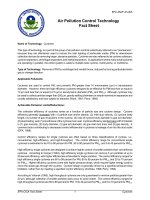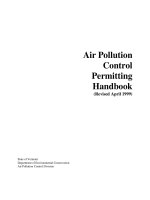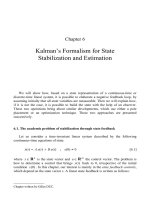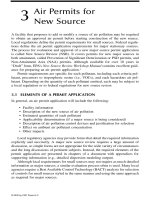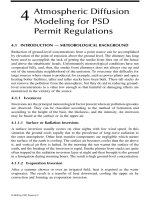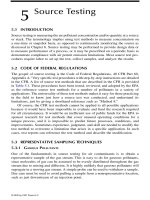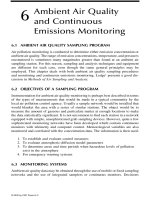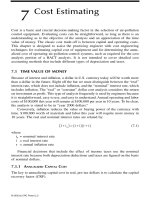AIR POLLUTION CONTROL TECHNOLOGY HANDBOOK - CHAPTER 6 pps
Bạn đang xem bản rút gọn của tài liệu. Xem và tải ngay bản đầy đủ của tài liệu tại đây (348.77 KB, 18 trang )
Ambient Air Quality
and Continuous
Emissions Monitoring
6.1 AMBIENT AIR QUALITY SAMPLING PROGRAM
Air pollution monitoring is conducted to determine either emission concentration or
ambient air quality. The range of emission concentrations, temperature, and pressures
encountered is sometimes many magnitudes greater than found at an ambient air
sampling station. For this reason, sampling and analysis techniques and equipment
are different for each case, even though the same general principles may be
employed. This chapter deals with both ambient air quality sampling procedures
and monitoring and continuous emissions monitoring. Lodge
1
presents a good dis-
cussion in
Methods of Air Sampling and Analysis.
6.2 OBJECTIVES OF A SAMPLING PROGRAM
Instrumentation for ambient air quality monitoring is perhaps best described in terms
of the types of measurements that would be made in a typical community by the
local air pollution control agency. Usually a sample network would be installed that
would blanket the area with a series of similar stations. The object would be to
measure the amount of gaseous and particulate matter at enough locations to make
the data statistically significant. It is not uncommon to find each station in a network
equipped with simple, unsophisticated grab sampling devices. However, quite a few
sophisticated monitoring networks have been developed which contain continuous
monitors with telemetry and computer control. Meteorological variables are also
monitored and correlated with the concentration data. The information is then used:
1. To establish and evaluate control measures
2. To evaluate atmospheric-diffusion model parameters
3. To determine areas and time periods when hazardous levels of pollution
exist in the atmosphere
4. For emergency warning systems
6.3 MONITORING SYSTEMS
Ambient air quality data may be obtained through the use of mobile or fixed sampling
networks and the use of integrated samplers or continuous monitors. Decisions
6
9588ch06 frame Page 67 Wednesday, September 5, 2001 9:46 PM
© 2002 by CRC Press LLC
regarding these monitoring techniques constitute the first important steps in design
of a monitoring network.
6.3.1 F
IXED
VS
. M
OBILE
S
AMPLING
Fixed-point sampling entails a network of monitoring stations at selected sites,
operated simultaneously throughout the study. Stations are permanent or, at least,
long-term installations. In a mobile sampling network, the monitoring/sampling
instruments are rotated on schedule among selected locations. The monitoring/sam-
pling is not conducted simultaneously at all locations, and the equipment is generally
housed in trailers, automobiles, or other mobile units. An advantage of fixed sampling
is that measurements are made concurrently at all sites, providing directly compa-
rable information, which is particularly important in determining relationship of
polluting sources to local air quality and in tracing dispersion of pollutants through-
out the area. The chief advantage of mobile sampling is that air quality measurements
can be made at many sites — far more than would be feasible in a fixed sampling
program. Mobile sampling provides better definition of the geographical variations
if the program is long enough to generate meaningful data.
6.3.2 C
ONTINUOUS
VS
. I
NTEGRATED
S
AMPLING
Continuous monitoring is conducted with devices that operate as both sampler and
analyzer. Pollutant concentrations are instantaneously displayed on a meter, contin-
uously recorded on a chart, magnetic tape, or disk. Integrated sampling is done with
devices that collect a sample over some specified time interval after which the sample
is sent to a laboratory for analysis. The result is a single pollutant concentration that
has been integrated, or averaged, over the entire sampling period. This is an older
technique and currently in limited use.
Continuous or automatic monitoring instruments offer some advantages over
integrating samplers; for example, there is a capability for furnishing short-interval
data, and there is a rapid availability of data. Moreover, output of the instruments
can be electronically sent to a central point. Also, continuous monitors require less
laboratory support. They also may be necessary to monitor some pollutants where
no integrating method is available or where it is necessary to collect data over short
averaging times, for example, 15 min. Automated monitors also have some draw-
backs. They require more sophisticated maintenance and calibration, and the oper-
ators and maintenance personnel have to be more highly technically trained.
The selection of a monitoring system is influenced by the averaging time for
which concentrations are desired, i.e., 15-min, 1-h, 3-h, 8-h, 12-h, or 24-h time
intervals. It should be consistent with the averaging times specified by air quality
standards. For example, in assessing SO
2
levels, good coverage can be provided by
use of integrated samples, widely dispersed over the area, and one or more contin-
uous sampler/analyzers situated in heavily populated areas. The integrated sampler
defines SO
2
levels over a broad area, and the continuous devices provide detailed
information on diurnal patterns. The short averaging time of interest for CO and
ozone dictates the use of continuous monitors for these pollutants.
9588ch06 frame Page 68 Wednesday, September 5, 2001 9:46 PM
© 2002 by CRC Press LLC
6.3.3 S
ELECTION
OF
I
NSTRUMENTATION
AND
M
ETHODS
Choice of instrumentation for an air-monitoring network depends on the following
factors:
• Type of pollutants
• Averaging time specified by air quality criteria or standards
• Expected pollutant levels
• Available resources
• Availability of trained personnel
• Presence in the air of interfering materials
Most pollutants may be monitored by a number of different methods and tech-
niques. The selection of the methodology to be used is an important step in the
design of the monitoring portion of the assessment study.
6.4 FEDERAL REFERENCE METHODS AND
CONTINUOUS MONITORING
In order to evaluate the current air quality and the effect of air pollution control
measures, most larger communities maintain monitoring networks. The EPA, as well
as most of the states, maintains its own surveillance networks. The ideal objective
when installing a monitoring network is to be able to obtain continuous real time
data. Table 6.1 lists standard methods of measurement. Only 3 of these standard
methods employ continuous or semicontinuous monitors.
No satisfactory device exists as yet for determining suspended particulate on a
continuous basis. However, Table 6.2 lists continuous methods which are now com-
monly employed for the measurement of the five regulated air pollutants.
TABLE 6.1
Federal Reference Methods
Pollutant Collection Method Analysis
Sulfur dioxide Absorption in bubbler Spectrophotochemically
Particulate matter Filtration in hi-volume sampler Gravimetrically
Carbon monoxide Continuous NDIR monitor Absorption of infrared energy
Nitrogen dioxide Continuous monitor Chemiluminescence reaction with ozone
Hydrocarbons Semi-continuous monitor Chromatographic separation with flame
ionization detector
Ozone Continuous monitor Chemiluminescence reaction with ethylene
Lead Filtration in hi-volume sampler Extracted by acid, atomic absorption
spectrometry
9588ch06 frame Page 69 Wednesday, September 5, 2001 9:46 PM
© 2002 by CRC Press LLC
Particulate matter emissions can be continuously detected through opacity mea-
surements. Opacity is a function of light transmission through the plume and is
define by the following equation
(6.1)
where
OP = percent opacity
I = light flux leaving the plume
I
0
= incident light flux
The following information, Documentation of the Federal Reference Methods
for the Determination of the Regulated Air Pollutants, can be found in the
Code of
Federal Regulations
, Title 40 (CFR 40) —
Protection of Environment
, Chapter 1,
Environmental Protection Agency, Subchapter C — Air Programs, Part 50, National
Primary and Secondary Ambient Air Quality Standards. The following is a list of
those methods with reference to CFR 40.
TABLE 6.2
Continuous Monitor Methods for Federally Regulated Pollutants
Pollutant Continuous Monitor Method
Sulfur dioxide Conductrometric
Coulometric
Flame chemiluminescence
Carbon monoxide Non-dispersive infrared or gas chromatograph, with conversion to methane, flame
ionization detection, a semicontinuous method
Nitrogen dioxide Coulometric
Chemiluminescent reaction with ozone
Hydrocarbons Gas chromatograph
Flame ionization detector
Semicontinuous
Ozone Coulometric
Chemiluminescent reaction with ethylene
Documentation of the Federal Reference Methods for the Determination
of Regulated Air Pollutants
Sulfur Dioxide
Appendix A
Reference Method for the Determination of Sulfur Dioxide in the Atmosphere (Pararosaniline Method)
Particulate Matter
Appendix B
Reference Method for the Determination of Suspended Particulate in the Atmosphere — High Volume
Method (Total suspended particulate has been replaced by PM
10
and PM
2.5
.)
OP I I=−
()
×1 100
0
9588ch06 frame Page 70 Wednesday, September 5, 2001 9:46 PM
© 2002 by CRC Press LLC
6.5 THE “COMPLETE” ENVIRONMENTAL SURVEILLANCE
AND CONTROL SYSTEM
An ideal surveillance and control system can be devised employing continuous
monitoring, telemetering, and electronic data processing. It is possible to assemble
such a system from the hardware components that are now available. The major
drawback of this automatic system is the limitations of the computer software; there
is little economic information available for formulating the ambient air quality and
optimizing models. Figure 6.1 illustrates one conception of a surveillance and control
system. This system would demand instruments which could be calibrated to a
known standard, would retain their calibration over long periods of time, would be
Carbon Monoxide
Appendix C
Measurement Principle and Calibration Procedure for the Continuous Measurement of Carbon Monoxide
in the Atmosphere (Non-Dispersive Infrared Spectrometry)
Ozone
Appendix D
Measurement Principle and Calibration Procedure for the Measurement of Photochemical Oxidants
Corrected for Interferences Due to Nitrogen Oxides and Sulfur Dioxide
Hydrocarbons
Appendix E (Corrected for Methane)
Reference Method for Determination of Hydrocarbons Corrected for Methane
Nitrogen Dioxide
Appendix F
Measurement Principle and Calibration Procedure for the Measurement of Nitrogen Dioxide in the
Atmosphere (Gas Phase Chemiluminescence)
Lead
Appendix G
Reference Method for the Determination of Lead in Suspended Particulate Matter Collected from Ambient
Air
Ozone
Appendix H
Interpretation of the National Ambient Air Quality Standards for Ozone
PM
10
Appendix J
Reference Method for the Determination of Particulate Matter as PM
10
in the Atmosphere
Particulate Matter
Appendix K
Interpretation of the National Ambient Air Quality Standards for Particulate Matter (Includes PM
2.5
)
9588ch06 frame Page 71 Wednesday, September 5, 2001 9:46 PM
© 2002 by CRC Press LLC
free of electronic drift over these long-time periods, and would possess suitable
dynamic response.
Many automated environmental surveillance systems employing continuous
monitors exist in the U.S. and throughout the world. None are quite as sophisticated
as would be implied by the system of Figure 6.1.
FIGURE 6.1
Conception of a surveillance and control system.
9588ch06 frame Page 72 Wednesday, September 5, 2001 9:46 PM
© 2002 by CRC Press LLC
6.6 TYPICAL AIR SAMPLING TRAIN
A typical air pollution sampling train is applicable to the intermittent collection of
an air sample containing either gaseous or particulate pollutants. The sample is
retained in the collection equipment which is then removed for the sample train.
Further processing takes place to prepare the sample for analysis. Most of the
analysis techniques are standard procedures involving one or more of the following
methods:
1. Gravimetric
2. Volumetric
3. Microscopy
4. Instrumental
a. Spectrophotometric
i. Ultraviolet
ii. Visible (Colorimetry)
iii. Infra-red
b. Electrical
i. Conductometric
ii. Coulometric
iii. Titrimetric
c. Emission Spectroscopy
d. Mass Spectroscopy
e. Chromatography
6.7 INTEGRATED SAMPLING DEVICES FOR SUSPENDED
PARTICULATE MATTER
Suspended particulate are small particulate that vary in size from less than 1 micron
to approximately 100 microns. They remain suspended in the atmosphere for long
periods of time and absorb, reflect, and scatter the sunlight, obscuring visibility.
When breathed, they penetrate deeply into the lungs. They also cause economic loss
because of their soiling and corrosive properties.
The new EPA ambient particulate-matter definition includes only the part of the
size distribution that could penetrate into the human thorax. This requires a sampling
inlet with a 10
µ
m cutpoint to mimic deposition in the extra thoracic regions.
Figure 6.2 is a schematic of a sampler designed to meet this requirement. There is
a two-stage selective inlet. Air is drawn into the inlet and deflected downward into
acceleration jets of the first-stage fractionator. Larger, non-inhalable particles are
removed. Air then flows through the first stage vent tubes and then through the
second fractionation stage. More non-inhalable particles are removed, and the
remaining aerosol is drawn through the usual 8
″
×
10
″
sampling filter. The new PM
10
standard includes only those particles with an aerodynamic diameter less than or
equal to 10
µ
m. This standard went into effect on July 31, 1987.
9588ch06 frame Page 73 Wednesday, September 5, 2001 9:46 PM
© 2002 by CRC Press LLC
6.8 CONTINUOUS AIR QUALITY MONITORS
Continuous emissions monitoring (CEM) is required by the Clean Air Act Amend-
ments to monitor SO
2
, NO
x
, CO, CO
2
, opacity, total hydrocarbons, and total reduced
sulfur (TRS). Title IV, which is to ensure compliance with the Acid Rain Program,
sets out provisions for CEM in the two-phase utility power industry control strategy.
Phase I Utilities were required to install CEM by November 15, 1993, and Phase II
Utilities by January 1, 1995. Title III focuses on 189 hazardous air pollutants (HAP),
some of which will possibly require CEM. This should spawn CEM techniques
optimized for the chemical compound being monitored. Title V will require CEM
for compliance assurance. The collection of real-time emission data will be the first
step to attaining the national mandated reduction in SO
2
and NO
x
emissions. Fur-
thermore, CEM can be used to track use of allowances in the new market-based SO
2
emissions trading program.
CEM is carried out by two general methods —
in situ
and extractive. Each of
the methods measures on a volumetric basis, ppm for example. Therefore, the
measurements require conversion to mass emission rates on a lb/h or lb/10
6
BTU
basis. Monitoring instrumentation requires at least 10% relative accuracy. Perfor-
mance specifications and test procedures can be found in Title 40 CFR, Part 60,
Appendix B.
FIGURE 6.2
Two-stage particulate sampler.
9588ch06 frame Page 74 Wednesday, September 5, 2001 9:46 PM
© 2002 by CRC Press LLC
The EPA Emission Measurement Center (EMC) at Research Triangle Park and
the Midwest Research Institute have created a data base on CEM. You may use
browse techniques or search the data base by HAP or analyzer type. The data base
is found on the EPA home page at: www.epa.gov/ttnami1/siteindx.html.
Figure 6.3 is a schematic flow diagram of a general continuous air-quality mon-
itor. The device contains:
1. Primary air-moving device, usually a vacuum pump, to pull the air sample
through the instrument
2. Flow-control and -monitoring device, usually a constant pressure regulator
and rotameter
3. Pollutant detection by various primary sensing techniques
4. Automatic reagent addition where needed
5. Electronic circuitry for transducing the primary signal to a signal suitable
for recording and telemetering
6. Provisions for automatic calibration, usually several solenoid valves which
can be operated remotely to connect the inlet gas to a scrubbing train for
removal of all pollutants and establishing a chemical zero, or, alternatively,
to one or more span gases for setting the chemical range of the instruments.
Many monitors of the general type described above have been developed for all
of the federally regulated gaseous pollutants and others as well. The remainder of
this section will provide details of these devices. This list is not exhaustive. Further-
more, although the devices described below are indicated for a particular pollutant,
they can be used for other types of pollutants as well.
6.8.1 E
LECTROCONDUCTIVITY
A
NALYZER
FOR
SO
2
Electrical conductivity was the basis of the first continuous monitor used to detect
and monitor an air pollutant — SO
2
. This monitor was built by a Dr. Thomas to
monitor SO
2
in a greenhouse during a study of the effects of SO
2
on plants. Later,
it was employed by TVA in its original studies of SO
2
from power plant plumes.
In an electroconductivity apparatus, a reagent passes through a reference con-
ductivity cell and then into an absorbing column. Air is drawn by a vacuum pump
counter-currently to the reagent flow through the absorbing tube, then through a
separator to the exhaust. The SO
2
is absorbed in the reagent which then passes
through a measuring conductivity cell. A stabilized AC voltage is impressed across
the conductivity cells resulting in a current flow that is directly proportional to the
conductivity of the solution. The value of this current is measured by connecting a
resistor in series with the cell to obtain an AC voltage which is proportional to the
current. This voltage is then rectified to direct current. The DC signals from the
rectifiers are connected in opposition, thus resulting in a voltage that induces a
current through a meter which is directly related to the difference in conductivity
between the two solutions. To set the zero on the instrument, any SO
2
is removed
by passing the air through a soda-lime absorber. The conductivity in both cells should
then be the same, and the meter output should be zero.
9588ch06 frame Page 75 Wednesday, September 5, 2001 9:46 PM
© 2002 by CRC Press LLC
FIGURE 6.3
Generalized automatic continuous air pollution monitor.
9588ch06 frame Page 76 Wednesday, September 5, 2001 9:46 PM
© 2002 by CRC Press LLC
© 2002 by CRC Press LLC
The principle of operation is as follows:
a. The SO
2
is oxidized in a reagent such as deionized water to form the
sulphate ion which will cause a conductometric change related to amount
of SO
2
present. The reaction is as follows,
b. Use of an acidified H
2
O
2
solution reduces interference from acid gases
such as CO
2
c. The method is basically simple. However, since conductivity is temperature
dependent, the analyzer section of any instrument must be thermostated.
6.8.2 C
OULOMETRIC
A
NALYZER
FOR
SO
2
Principle of operation of a coulometric analyzer is similar to an electroconductivity
apparatus, except three electrodes are required. One is a reference electrode.
Figure 6.4 shows the three-electrode circuit. An air sample is drawn through a
detector cell which contains a buffered solution of KI. Then iodine, I
2
, is generated
at the anode,
FIGURE 6.4
Electrical circuit for a coulometric continuous monitor.
H O SO H SO
HSO O HSO
2223
23
1
2
224
+→
+→
SO H O H SO
222 24
+→
22
2
IIe
−−
→+
9588ch06 frame Page 77 Wednesday, September 5, 2001 9:46 PM
© 2002 by CRC Press LLC
The SO
2
is oxidized by the I
2
. Unreacted iodine is reduced to iodide, I
–
, at the
cathode.
Due to the loss of I
2
by reaction with SO
2
, the cathode current is less than the
anode current. The difference is proportional to the SO
2
concentration through a
Faradaic expression. The reference electrode serves as a reference to both poles and
registers this imbalance in anodic input current and cathodic output current,
i
r
= i
a
= i
c
. A selective scrubber removes interferents such as O
3
, mercaptans, and
H
2
S, improving specificity of instrument. A zero gas is provided by using an activated
carbon filter to remove impurities in air, including SO
2
. The gas flow is regulated
by pressure control and a capillary tube which provides a constant pressure and
pressure drop, and thus a constant flow. A pulsation damper adds volume to the
system to provide stability of flow. The water supply is constantly replenished when
evaporation occurs.
6.8.3 N
ONDISPERSIVE
I
NFRARED
M
ETHOD FOR CO
Over the past 40 years, continuous infrared spectrometers have grown to be one of
the most satisfactory instruments for determining carbon monoxide concentration
in the atmosphere. The nondispersive instruments do not employ spectral separation
of the radiation but make use of the specific radiation absorption of heteroatomic
gases in the infrared range between 2.5 and 12 µm. The total absorption in the range
is measured by an alternating light photometer with two parallel beams and a
selective radiation receiver. The sample gas is passed through the sample cell which
is arranged parallel to a reference cell containing a gas which absorbs no radiation.
The radiation emitted by two nickel-chrome filaments reaches the two receiving
cells after passing through the sample cell and reference cell, respectively. The
receiving cells are filled with the gas component to be measured (CO in this case)
and are separated by a metal diaphragm. The incident radiation is absorbed selec-
tively in the specific absorption bands. Every gas has an absorption spectrum con-
sisting of one or two individual absorption bands which are specific for the gas.
Carbon monoxide has a band from 4.5–5.0 µm. The absorbed energy is transformed
into thermal energy. Any difference in absorbed energy produces a temperature and
pressure difference between the two receiving cells. This pressure difference deflects
the diaphragm and thus changes the capacitance of the diaphragm capacitor. The
diaphragm capacitor is connected to a high-impedance resistor which generates an
alternating millivolt voltage that can be amplified, rectified, and displayed by a
recorder.
All infrared analyzers employ the same nondispersive measurement principle,
but there are differences in the manufacturer’s design. One major difference among
the analyzers is the length of the measuring cell. The length of the cell has little
effect on the measuring range of the analyzer, and both analyzers are capable of
being changed to provide several measuring ranges.
Ie I
2
22+→
−−
9588ch06 frame Page 78 Wednesday, September 5, 2001 9:46 PM
© 2002 by CRC Press LLC
Two infrared sources are used, one for the sample energy beam, the other for
the reference energy beam. The beams are blocked simultaneously ten times per
second by the chopper, a two-segmented blade rotating at five revolutions per second.
In the unblocked condition, each beam passes through the associated cell and into
the detector. The sample cell is a flow-through tube that receives a continuous stream
of sample. The reference cell is a sealed tube filled with a reference gas. The reference
gas is selected for minimal absorption of infrared energy of those wavelengths
absorbed by the sample component of interest.
The detector consists of two sealed compartments separated by a flexible metal
diaphragm. Each compartment has an infrared transmitting window, to permit entry
of the corresponding energy beam. Both chambers are filled, to the same subatmo-
spheric pressure, with the vapor of the component of interest. Use of this substance
as the gas charge in the detector causes the instrument to respond only to that portion
of net difference in energy due to the presence of the measured component.
In operation, the presence of the infrared-absorbing component of interest in the
sample stream causes a difference in energy levels between the sample and reference
sides of the system. This differential energy increment undergoes the following
sequence of transformation:
a. Radiant energy: In the sample cell, part of the original energy of the
sample beam is absorbed by the component of interest. In the reference
cell, however, absorption of energy from the reference beam is negligible.
b. Temperature: Inside the detector, each beam heats the gas in the corre-
sponding chamber. However, since energy of the reference beam is greater,
gas in the reference chamber is heated more.
c. Pressure: Higher temperature of gas in the reference chamber raises the
pressure of this compartment above that of the sample chamber.
d. Mechanical energy: Gas pressure in the reference chamber distends the
diaphragm toward the sample chamber. The energy increment is thus
expended in flexing the diaphragm.
e. Capacitance: The diaphragm and the adjacent stationary metal button
constitute a two-plate variable capacitor. Distention of the diaphragm
away from the button decreases the capacitance.
When the chopper blocks the beams, pressures in the two chambers equalize,
and the diaphragm returns to the undistended condition. As the chopper alternately
blocks and unblocks the beams, therefore, the diaphragm pulses, thus changing
detector capacitance cyclically. The detector is part of an amplitude modulation
circuit that impresses the 10 Hz information signal on a 10 MHz carrier wave
provided by a crystal-controlled radio-frequency oscillator. Additional electronic
circuitry in the oscillator unit demodulates and filters the resultant signal, yielding
a 10 Hz signal. The 10 Hz signal is routed to the amplifier/control section for
amplification and phase inversion, then back into the analyzer section for synchro-
nous rectification. The resulting fullwave-rectified signal is returned to the ampli-
fier/control section for filtering and additional conditioning, as required, to drive the
meter and recorder.
9588ch06 frame Page 79 Wednesday, September 5, 2001 9:46 PM
© 2002 by CRC Press LLC
6.8.4 FLAME PHOTOMETRIC DETECTION OF TOTAL SULFUR AND SO
2
Sulfur compounds introduced into a hydrogen-rich flame produce strong luminescent
emissions between 300 and 423 nm. A narrow-band optical filter placed between
the flame and detector permits transmission at 394 ± 5 nm. This produces a specificity
ratio of between 10,000 and 30,000 to 1 for sulfur compounds. A photomultiplier
tube detects the emission.
When it is desired to study a mixture of sulfur compounds such as SO
2
, H
2
S,
CS
2
, and CH
2
SH, the mixture is first passed through a gas chromatograph. A typical
column employs 24 ft of 1/8 in. i.d. tubing packed with 30 to 40 mesh Teflon
®
which
is coated with 10% polyphenol containing phosphoric acid. For the usual ambient
conditions, the use of a chromatographic column is not warranted since the sulfur
in ambient air is usually in the form of SO
2
.
6.8.5 HYDROCARBONS BY FLAME IONIZATION
A simple hydrocarbon monitor can be built using a flame ionization detector. Carbon
atoms produce ions in a hydrogen flame. Thus, the air stream containing hydrocar-
bons is fed into a hydrogen flame. The ions produced are detected by an electrometer.
The hydrocarbon concentration is proportional to the current.
It has been found that CH
4
can be separated by gas chromatographic technique
from other hydrocarbons. An employing flame ionization detection has been con-
structed. Carbon monoxide is detected in the device by catalytically converting the
CO to CH
4
over a nickel catalyst after it has been separated from the rest of the
gases by the gas chromatographic technique.
6.8.6 FLUORESCENT SO
2
MONITOR
Sulfur dioxide molecules fluoresce when irradiated by ultraviolet light in the 1900 to
3000 nm waveband. The optimum excitation takes place in the narrower range
between 2100 and 2300 nm. An ultraviolet light such as a quartz deuterium lamp
is used to produce the source of radiation. Selective narrow-band transmission is
achieved by optical filters. Subsequently, the collimated narrow-band light beam
then passes through a reaction chamber, where the sample also flows. The resultant
fluorescence, directly proportional to the number of SO
2
molecules present in the
reaction chamber, is then measured by a blue sensitive photomultiplier tube.
6.8.7 CHEMILUMENESCENCE FOR DETECTION OF OZONE
AND NITROGEN OXIDES
In 1889, Arrhenius first proposed that an energy of activation was required in order
for a chemical reaction to take place. By acquiring this activation energy, a reacting
molecule or atom could combine with other molecules or atoms in a chemical
reaction. Around 1914 to 1930, the collision theory of reaction prevailed in which
the molecules were postulated to acquire the necessary energy of activation by
colliding with each other. Molecules were then conceived to be somewhat like hard
spheres, and the rate of reaction was determined to be proportional to the number
9588ch06 frame Page 80 Wednesday, September 5, 2001 9:46 PM
© 2002 by CRC Press LLC
of collisions of these marble-like molecules in a given time. Quantum theory of the
1920s introduced the idea of probability, and the round-sphere idea was replaced by
the probability function.
Building on the Arrhenius activation energy idea and the probability theory of
quantum mechanics, Eyring and Polyani in 1931 proposed an activated complex
theory
2
of chemical reaction. This theory looks at the potential energy of the reacting
system as the molecules come closer together. The rate of reaction is then found as
the probability of a molecule crossing an energy barrier. In order to cross the barrier,
the molecule must become an activated complex. The picture one can write of a
chemical reaction is illustrated by the nitric oxide–oxygen reaction.
Thus, the collision of hard spheres is replaced by a smooth continuous transition
of reactants to products.
In a photochemical reaction, the activation energy comes from a quarter of light.
This light may be obtained from the ultraviolet or infrared region as well as from
the visible range. Photochemical reactions are primary processes; however, lumi-
nescence belongs to a class of reactions in which a secondary photochemical process
takes place after the acquisition of an initial energy. Four luminescence processes
are recognized.
1. Fluorescence — after excitation by light there is an emission of light of
a different wave length.
2. Phosphorescence — where an emission of light continues after the exci-
tation source is removed.
3. Thermoluminescence — where, for example, crystals are irradiated with
X-rays. Electrons are excited and trapped at a higher energy level. When
the crystal is heated, the electrons drop to a lower energy level with the
emission of light.
4. Chemiluminescence — which is an emission of light as a result of a
chemical reaction at environmental temperature.
An example of chemiluminescence is the reaction between nitric oxide and ozone.
1. NO in lower energy state than O
3
becomes activated.
2. NO crosses over to the O
3
energy level.
3. An activated complex is formed between (NO) and O
3
.
2
2
22
22
NO O NO O
NO O NO
+→ −
()
−
()
→
Activated
Complex
NO NO→
()
‡
NO NO O
()
→−
()
‡
‡
3
9588ch06 frame Page 81 Wednesday, September 5, 2001 9:46 PM
© 2002 by CRC Press LLC
4. Reaction proceeds to nitrogen dioxide leaving NO
2
in a higher energy
state.
5. NO
2
drops to a lower energy state with the emission of a quanta of light, hv.
Commercial monitors have been developed employing this process. Ozone is
detected in reaction with ethylene. Nitric oxide is detected in reaction with ozone,
and nitrogen dioxide is detected by first reducing it to nitric oxide then using the
ozone reaction.
6.8.8 CALIBRATION OF CONTINUOUS MONITORS
6.8.8.1 Specifications for Continuous Air-Quality Monitors
It is unfortunate that terms used in specifying and calibrating air-monitoring instru-
mentation are sometimes ambiguous. Thus we find the term “dynamic” dilution
being used to mean diluting a flowing gas stream under carefully controlled constant
flow conditions to produce an accurately and precisely known concentration. A
preferred term would be “steady state” dilution which can be used to describe gas
in flow but has none of the connotation of transient which the term dynamic might
imply. To be most useful, specifications for instrumentation where flowing fluids are
involved should provide information about the instrument which would impart to
the user a knowledge about both its steady state and transient performance.
Steady-state calibrations should be made at several levels of concentration over
the expected range of concentrations that will be found. Comparison to the accepted
standard method, absorption in a bubbler with West and Gaeke analysis for sulfur
dioxide, for example, should be made as well. Replicate runs at the several levels
of concentration can be compared through statistical analysis using factors such as
the multiple correlation coefficient. In addition, the drift of the zero and span or
range of the instrument should be low so that very little error will be introduced
into the accuracy and precision of the instrument.
Dynamic response testing can be used to determine transient and frequency
response characteristics of continuous monitors. The most complete dynamic
description of a system is its transfer function which is the ratio of the Laplace
transformed output signal to the Laplace transformed input signal. Knowing the
transfer function means that the output signal can be determined from any given
input signal. Frequency response curves are essentially a graphical record of the
transfer function and are thus useful to depict the dynamic response of a system.
Transient response curves such as might be provided from a step test are valid only
for the particular input function which produced the curves and are, thus, of limited
NO O NO O−
()
→
()
+
322
‡
‡
NO NO h
22
()
→+
‡
v
9588ch06 frame Page 82 Wednesday, September 5, 2001 9:46 PM
© 2002 by CRC Press LLC
usefulness. Even more limited in specifying instruments is the rise time and fall
time, which provides no information about the shape of the transient curve. The bad
news is the difficulty to which the experimenter is put in order to determine the
transient characteristics or the transfer function. The good news is that the need for
the detailed transient information provided by the transfer function is not usually
required.
Additional instrument specifications are concerned with the effect of the ambient
conditions imposed on the instrument including interfering substances. A common
glossary of terms follows. These terms have been classified according to definition,
steady-state specification, dynamic specification, or ambient specification.
6.8.8.2 Steady-State Calibrations
One of the most difficult problems encountered in calibrating air pollution instru-
mentation is the production of low-level concentrations which are in the range
encountered in the atmosphere. There are several suppliers of gas cylinders with
prepared and certified low-level gas concentrations.
Most usually these gases will have to be diluted before use, which poses a
problem in maintaining strictly controlled temperatures, pressures, and flow rates.
This writer discovered a paradox when using a cylinder of carbon monoxide prepared
to a specified low concentration. A small but significant difference between two low
levels of concentration was found when calibrating a nondispersive infrared analyzer
(NDIR). The companies supplying the gases were contacted. One company reported
that they were sure of their analysis because they used the best instrument for low-
level carbon monoxide concentration determination — a nondispersive infrared
instrument. The net result was that the company was comparing NDIR instruments
and not conducting a calibration with a true standard. From the author’s viewpoint
this situation is to be avoided.
The permeation tube is a device which can
provide low-level concentrations. These tubes
are made of a material such as Teflon and con-
tain a compound whose concentration is
desired, sealed into the tube as a liquid. The
vapor will then permeate through the walls of
the tube at a constant rate dependent on the
surface area exposed and the temperatures to
which the tube is subjected. The basic determi-
nation of permeation rate can be made gravi-
metrically; thus, a permeation tube can become
a true standard. Table 6.3 lists some of the
gases for which permeation tubes are available.
Tubes of proper length can be used to calibrate gas analyzers at a steady-state
flow condition. An apparatus must be prepared to hold the tube in a pure-air or
nitrogen stream of known flow rate and at a constant temperature. A tube holder
may be made from a standard vacuum trap with the tube in the center well and the
outer section filled with glass beads to promote heat exchange. The tube holder is
TABLE 6.3
Available Permeation Tubes
Sulfur dioxide Propane
Nitrogen dioxide Propylene
Hydrogen sulfide Butane
Chlorine Butene-1
Hydrogen fluoride Cis-butene-2
Dimethyl sulfide Trans butene-2
Dimethyl disulfide Ethylene oxide
Methyl mercaptan Others
9588ch06 frame Page 83 Wednesday, September 5, 2001 9:46 PM
© 2002 by CRC Press LLC
placed in a constant temperature bath. Concentration can be varied through a manip-
ulation of pure carrier gas flow rate, temperature, or tube length.
The length of the tube required to produce the desired gas concentration can be
estimated from the formula given below:
(6.2)
where
L = length in cm
C = concentration in ppm (vol)
F= flowrate of carrier gas in cm
3
/min
K = constant dependent upon gas at 1 atm, 25°C
0.382 for SO
2
; 0.532 for NO
2
; 0.556 for propane
P
t
= permeation rate for stated operating temperature
Note that concentration can be varied by changing tube temperature or length
or carrier gas flowrate.
REFERENCES
1. Lodge, J. P., Jr., Ed., Methods of Air Sampling and Analysis, Interscience Committee
of A&WMA, ACS, AIChE, APWA, ASME, AOAC, HPS, and ISA; Lewis Publishers
Inc., Chelsea, MI, 1989.
2. Glasastone, S., Laidler, K. J., and Eyring, H., The Theory of Rate Processes, McGraw-
Hill Book Co., New York, 1941.
L
CF
KP
t
=
9588ch06 frame Page 84 Wednesday, September 5, 2001 9:46 PM
© 2002 by CRC Press LLC
